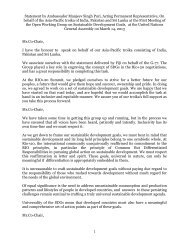STATE OF THE WORLD'S CITIES 2012/2013 Prosperity
STATE OF THE WORLD'S CITIES 2012/2013 Prosperity
STATE OF THE WORLD'S CITIES 2012/2013 Prosperity
You also want an ePaper? Increase the reach of your titles
YUMPU automatically turns print PDFs into web optimized ePapers that Google loves.
State of the World’s Cities <strong>2012</strong>/<strong>2013</strong><br />
regulatory frameworks and<br />
strong institutions – form<br />
the ‘hub’ that controls the<br />
‘wheel of urban prosperity’<br />
and give it direction,<br />
pace and momentum<br />
(see Chapter 1.1). Shared<br />
prosperity requires the<br />
predominance of the public<br />
interest as embodied in<br />
public authorities50 to<br />
ensure that none of the five<br />
‘spokes’ gain prevalence to<br />
the detriment of the others.<br />
Abstract values and norms<br />
are institutions because<br />
they guide individual<br />
and collective action. 51<br />
In the cities<br />
FACT of the world<br />
today, the power to be<br />
mobilised against the crisis<br />
emanates from a variety of<br />
stakeholders, not just public<br />
authorities, although these<br />
retain a decisive role.<br />
The crucial<br />
POLICy role of public<br />
authorities is to harness the<br />
various types of societal<br />
powers and potentials<br />
through appropriate urban<br />
power functions.<br />
Box 3.2.2 shows how, in<br />
China and in Europe centuries ago, the State imposed the<br />
prevalence of the public over other interests and needs,<br />
treating them all equitably for the sake of shared prosperity.<br />
The powers and functions that are part of the governance<br />
structure of a city may derive from promulgated city charters,<br />
local government frameworks, or directly from the national<br />
Constitution. The rights and responsibilities granted to<br />
individuals and firms in cities are all dictated by prevailing<br />
legal frameworks. Similarly, the interactions among urban<br />
residents as well as the modalities of production, distribution<br />
and consumption of urban space have always been regulated<br />
by explicit and implicit codes of behaviour and practice. The<br />
transformative potential of any city has, therefore, always<br />
been a function of the enabling scope of its laws, regulations<br />
and institutions. The degree to which such instruments can<br />
be deployed as they are, or consolidated, or even reformed<br />
will determine a city’s degree of prosperity.<br />
In the metaphor of the ‘<strong>Prosperity</strong> Wheel’, the legal and<br />
institutional framework as a whole acts as the ‘hub’ which<br />
steers the development<br />
of the five dimensions<br />
(‘spokes’) of prosperity,<br />
Laws and the modulating momentum,<br />
FACT associated<br />
relaying its energy to the<br />
institutional set-up<br />
other dimensions, and<br />
have determined the<br />
maintaining the overall<br />
very genesis of the<br />
modern city, both in its balance of the ‘wheel’.<br />
essence as well as its Internal dysfunctions in<br />
functionality.<br />
the legal and institutional<br />
116<br />
framework, or any disconnect between the hub and the<br />
spokes, interferes with the operation of the ‘wheel’ and<br />
makes any existing momentum unsustainable (such as based<br />
on only one of the five dimensions).<br />
<strong>THE</strong> LEGAL-INSTITUTIONAL BASIS <strong>OF</strong> <strong>THE</strong><br />
20TH-CENTURy CITy<br />
Advances in industrial development, consolidation of the<br />
market economy and the permeating influence of liberal<br />
democracy (both in its origin in the West and the postcolonial<br />
variant in the developing world) have created a<br />
shared legal and regulatory foundation in much of the urban<br />
world. The legal, regulatory and institutional fundamentals<br />
of the contemporary city tend to be identical, differing only<br />
in levels of development, institutional characteristics and<br />
performance ability. Indeed, the legal-institutional basis of<br />
the 20th-century city is fairly uniform; and this explains the<br />
similarities not only in functional modalities but also in the<br />
all-too visible imbalances characterizing the 20th-century<br />
city in its generic sense (i.e., spatial segregation, social<br />
exclusion, a predominance of motorised mobility, high<br />
Karnataka, Bangalore, India: A road sign hangs over the entrance<br />
to ‘Electronics City’, an industrial complex dedicated to the IT<br />
and electronics industries. Located ten miles (16km) outside<br />
Bangalore, the complex has been hugely successful in attracting<br />
foreign investment.<br />
© Chris Stowers/Panos Pictures


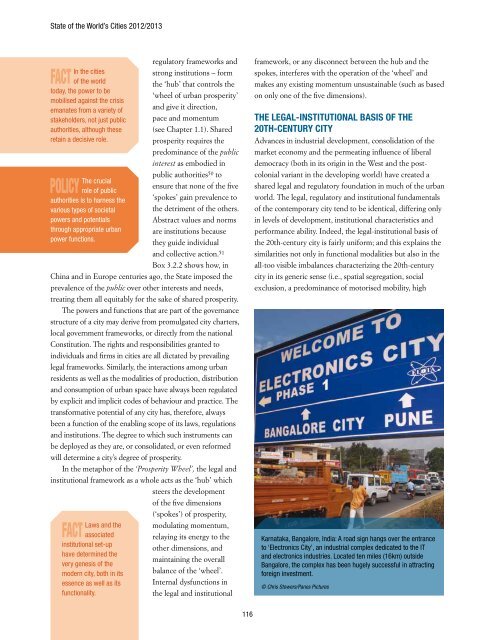

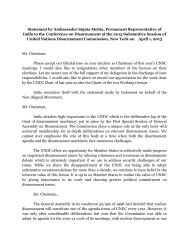
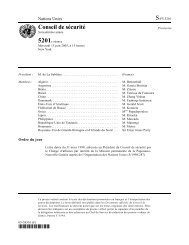
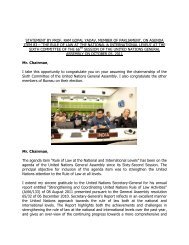
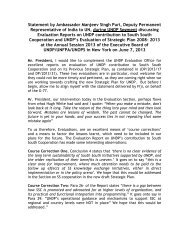
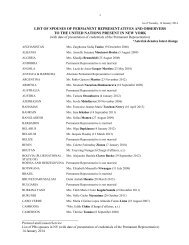
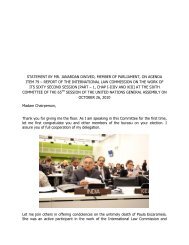
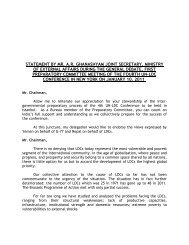
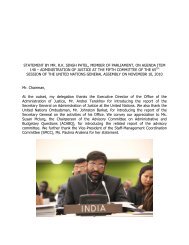

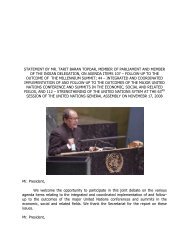
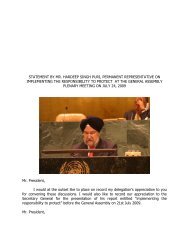
![1 statement by dr.[mrs] kakoli ghosh dastidar - Member States Portal](https://img.yumpu.com/27526598/1/190x245/1-statement-by-drmrs-kakoli-ghosh-dastidar-member-states-portal.jpg?quality=85)
